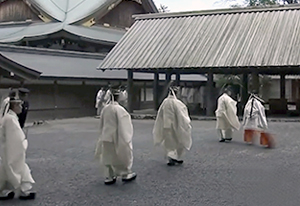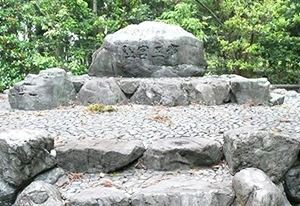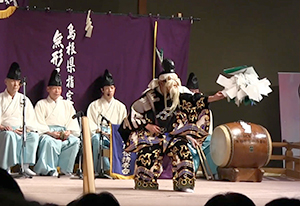天照大神に関する覚書
A Note on Amaterasu Omikami
Bottle No.1 「大嘗祭」と日本のはじまり
1. 令和の大嘗祭
2019年5月1日に、明仁(平成)天皇が退位され、皇太子徳仁親王が即位され、元号も平成から令和に改元され、既に6年が過ぎました。
天皇が即位されると、一代限りの大嘗祭(だいじょうさい)が大々的に執り行われます。7月以前の即位であれば、その年の11月半ばに「大嘗祭」が、7月以降の即位であれば、翌年の11月に「大嘗祭」が執り行われる仕来りです。
では「大嘗祭」とは何かというと、まずは「新嘗祭(にいなめさい)」について見ておかねばなりません。
新嘗祭・大嘗祭、共に新穀(稲)を天皇が、天照大神や祖神に供するとともに自らも食する収穫祭のことを言います。大嘗祭は、新天皇が初めて行う新嘗祭のことを言い、新天皇のそれこそ一世一代の神聖な行事となるものです。行事の主舞台となる悠紀(ゆき)院・主基(すき)院での儀式が、新天皇ただ一人で行われる秘事とされていることでも分かるように、新天皇即位の最も重要な儀式となるものです。
では次に大嘗祭の運営日程について時系列で簡単に見ていきましょう。斎田選定に関して
◎令和天皇の大嘗祭では、即位前の2018年5月18日に斎田(さいでん)選定の儀式が、宮中三殿の神殿の前庭で亀卜(かめうら)によって占われます。新天皇の即位前に行われるのを不思議に思われる方もおられると思いますが、毎年新嘗祭が行われるので、即位前でも斎田選定の儀式は行われているわけです。
斎田は、東国から悠紀(ゆき)、西国から主基(すき)の2斎田が選ばれますが、「悠紀」が最も神聖とされ、「主基」は「次」という意味合いを持っています。
令和の大嘗祭では、悠紀国に栃木県、主基国に京都府が選ばれました。
◎2019年9月27日、悠紀(ゆき)・主基(すき)両国に抜穂使(ぬきほのつかい)が派遣され、神田から稲を抜きとる儀式が行われました。ちなみに、この時の稲の品種は、「とちぎの星」(栃木県)と「キヌヒカリ」(京都府)といわれています。大嘗宮の建設に関して
◎2019年7月16日から大嘗宮の建設が開始され、10月末日に完成します。これは大極殿の前庭に悠紀院・主基院の大嘗宮が設営されますが、この建物は大嘗祭のたびごとに新たに造営される一世一代の建築物で、令和の大嘗宮の建設費は、約12億5500万円だったと言います。大嘗祭とその準備のための儀式について
◎10月、宮中三殿で、新天皇の禊(みそぎ)が行われました。明治以前は、10月下旬に、天皇が鴨川に臨行してを行い、物忌みが課せられたと言います。
◎こうして、当日、令和元年(2019年)11月14日の日没から15日未明にかけて、皇居で「大嘗宮の儀」が行われ、天皇陛下が新穀を神々に供え、自らも召し上がり、国家国民の安寧と五穀豊穣を祈られました。
大嘗祭終了後の措置
◎11月18日、一般公開に先立ち、大嘗宮の儀式に参列した人々を招いて、天皇陛下がお酒や料理を振る舞われる「大饗の儀」が催されました。
◎11月21日、「おたきあげ」の儀として、大嘗祭で不要になった建材の一部を焼却し清める儀式が行われました。その際、火は天照大神を祭る賢所から運ばれたと言います。
◎11月21日~12月8日まで、大嘗宮は一般公開され、一般公開終了後に解体され、廃材はバイオマス発電の燃料として再利用されたと言います。
2. 日本の始まり以上、長々と令和の大嘗祭について書きましたが、というのは、僕自身、壬申の乱終結後の天武天皇の国づくりに興味を持っており、そのことを調べる過程で、この大嘗祭を始めたのが天武天皇だと知りました。
そればかりか、天皇という呼称が使われだしたのも、日本という国号が使われだしたのも、伊勢神宮の20年ごとの遷宮の始まりも、その伊勢神宮を天皇家として祭る斎宮御所の運営も、全部が全部、壬申の乱終結後の国づくりのため天武天皇がはじめ、それを次代の持統女帝が受け継ぎ発展させたものだということを知りました。
それを知った時は、全身に鳥肌が立つような驚きでした。
そして、それらの政策がすべて「天照大神」を国家神に据えての国づくりにつながっていったのです。
そこで、次回「持統天皇と大津皇子」の関係から天武新体制について見ていくことにします。
ついで「持統天皇と草壁皇子」について考察し、さらに「天武・持統朝の国づくりと天武の子供たち」、最後は「大伯皇女と巫女の終焉」について考察することで、天照大神と日本という国について考えていきたいと思います。
令和の大嘗祭(TV TOKYOの報道番組から) 斎宮御所跡の碑(三重県多気郡明和町) いわみ神楽「天岩戸」(無形文化財)
Bottle No.1 The Great Thanksgiving Rite (Daijōsai) and the Beginning of Japan
1. The Daijōsai of the Reiwa EraOn May 1, 2019, Emperor Akihito (the Heisei Emperor) abdicated, and Crown Prince Naruhito ascended the throne. With his accession, the era name changed from Heisei to Reiwa, and six years have already passed.
When a new emperor ascends the throne, a once-in-a-lifetime ceremony known as the Daijōsai is held. By custom, if the enthronement occurs before July, the Daijōsai takes place in November of that year; if after July, it is held in November of the following year.To understand the Daijōsai, we must first look at the Niinamesai. Both the Niinamesai and the Daijōsai are harvest rituals in which the emperor offers newly harvested rice to Amaterasu Ōmikami and the ancestral deities, and also partakes of it himself. The Daijōsai is the first Niinamesai performed by a new emperor, and is therefore a sacred, one-time rite of profound significance. At its heart are the rituals in the Yuki and Suki halls, performed in secret by the emperor alone—underscoring its status as the most important ceremony of enthronement.
Here is a brief chronology of the 2019 Daijōsai:
- Selection of Sacred Rice Fields
On May 18, 2018—before the enthronement—the "Ritual of Rice Field Selection" was held in the forecourt of the Imperial Palace's Three Shrines, using turtle-shell divination (kiboku). One field, called Yuki, is chosen from the eastern provinces, and another, called Suki, from the western provinces. For the Reiwa Daijōsai, Tochigi Prefecture was selected as Yuki, and Kyoto Prefecture as Suki. On September 27, the sacred rice was ceremonially harvested: the varieties used were Tochigi no Hoshi (from Tochigi) and Kinuhikari (from Kyoto).
- Construction of the Daijō Palace
Construction of the temporary Daijō Palace began on July 16, 2019, and was completed at the end of October. Built in the forecourt of the Daigokuden, the complex—housing the Yuki and Suki halls—is newly constructed for each Daijōsai. The cost for the Reiwa structure was approximately 1.255 billion yen.
- The Ceremony Itself
In October, the new emperor underwent a ritual purification (misogi). From the evening of November 14 to the early hours of November 15, 2019, the "Rite of the Daijō Palace" was conducted at the Imperial Palace. The Emperor offered the new rice to the deities and partook of it himself, praying for the peace of the nation and abundant harvests.
- Post-Ceremony Events
On November 18, the Daikyō no Gi was held, where the Emperor hosted participants of the Daijōsai with food and sake. On November 21, the "Otakiage" rite was performed, in which some of the unused timber from the ceremony was ritually burned; the fire was said to have been brought from the Kashiko-dokoro, the shrine dedicated to Amaterasu Ōmikami within the palace. From November 21 to December 8, the Daijō Palace was opened to the public. Afterward, it was dismantled, and the timber was repurposed as biomass fuel.2. The Beginning of Japan
My interest in the Daijōsai began while studying Emperor Tenmu's nation-building efforts after the Jinshin War, when I discovered that it was Tenmu who first established this rite.
Even more astonishing was learning that so many other foundations of Japan trace back to him: the use of the title "Tennō" (Emperor), the adoption of "Nihon" as the nation's name, the institution of the twenty-year renewal (Shikinen Sengū) at Ise Grand Shrine, and the establishment of the Saikū Palace for imperial priestesses who served there. All of these were initiated by Emperor Tenmu and further developed by his successor, Empress Jitō.
When I realized this, I was struck with awe—it was as if goosebumps ran across my entire body.
And all of these policies were directed toward making Amaterasu Ōmikami the central deity of the nation.In the next installment, I will examine the new regime under Emperor Tenmu, beginning with the relationship between Empress Jitō and Prince Ōtsu. From there, I will consider Empress Jitō and Prince Kusakabe, the nation-building efforts of the Tenmu–Jitō court and their children, and finally the role of Princess Ōku and the decline of the priestess tradition. Through these, I hope to explore the relationship between Amaterasu Ōmikami and the formation of Japan as a nation.
The Daijōsai of the Reiwa Era
(from a TV TOKYO news program)Monument of the Former Saikū Palace Site
(Meiwa Town, Taki District, Mie Prefecture)Iwami Kagura "Ama-no-Iwato"
(Intangible Cultural Property)


